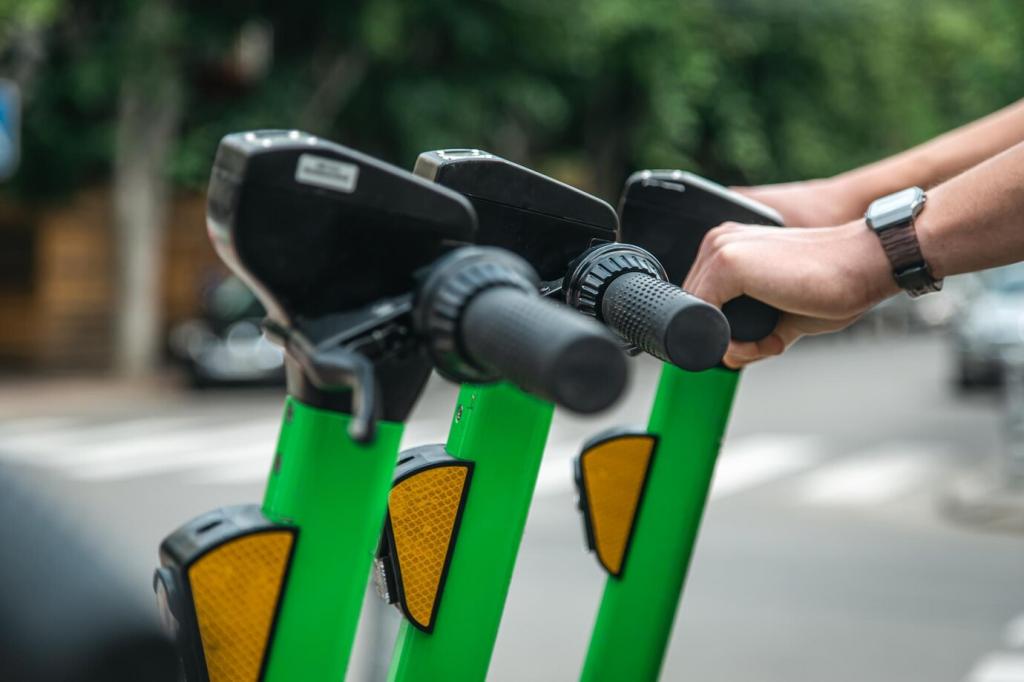Electric Scooter Models Compared: A Buyer’s Guide
Chosen theme: Electric Scooter Models Compared: A Buyer’s Guide. From daily commutes to weekend detours, this page helps you compare electric scooter models with confidence through clear criteria, lived stories, and tools you can use today. Share your priorities in the comments and subscribe for deep dives and updates.
Motor Power and Torque, Beyond Big Numbers
Peak wattage looks impressive, yet sustained power and torque curves govern hill starts, headwinds, and heavy backpacks. Compare continuous ratings, controller limits, and thermal management to understand how a scooter actually accelerates. Tell us your steepest climb, and we’ll suggest torque-focused models worth testing on your route.
Battery Capacity, Range, and the Weather Factor
Watt-hours indicate potential range, but temperatures, rider weight, elevation, and stop‑and‑go traffic reshape outcomes. Ask for standardized range tests at your average speed. Track degradation after 100 cycles to see which packs hold capacity. Comment with your typical speed and climate, and we’ll help estimate real distance.
Weight, Foldability, and Daily Carry Reality
A two-minute elevator ride and a crowded train platform can make a light, compact scooter feel priceless. Examine latch robustness, folded footprint, and handle placement. Try lifting with one hand before buying. Share your multi‑modal routine so readers can compare compact models that match similar daily constraints.
For three to five urban miles with frequent lights, prioritize nimble steering, predictable brakes, and fast charging. Pneumatic tires or well‑tuned suspension tame potholes and seams. Consider integrated lights and fenders for visibility. Tell us your neighborhood terrain and we’ll recommend agile models built for dense streets.
Which Scooter Fits Your Commute?
Safety and Reliability Across Models
Braking Systems and Real Stopping Distances
Mechanical discs are simple; hydraulics add modulation and power; regen assists on long descents. Measure stopping distance from 25 km/h, not just component names. One rainy Tuesday, a rider avoided a spill because properly bedded pads bit predictably. Share your emergency stop test so others can benchmark safely.
Traction, Tires, and Suspension Tuning
Pneumatic tires cushion and grip, while solid tires remove flats but transfer vibration. Dual suspension can shine if well tuned, yet poor damping bounces unsettlingly. Match tire width to rim and pressure to weight. Comment with your road surface mix to compare models that track securely in corners.
Weather Protection and Durability
IP ratings help, yet cable routing, gasket quality, and charge‑port covers tell the full story. Frequent drizzle, puddles, or coastal air challenge seals and fasteners. Seek stainless hardware and drain paths. Share your climate and storage habits, and the community will highlight models proven against the elements.


Comfort and Ergonomics You Actually Feel
A longer, wider deck supports staggered stances and reduces fatigue. Rounded edges and grippy surfaces matter in wet shoes. Try mock stances at home to gauge comfort. Tell us your shoe size and preferred posture so readers can point to models with decks that truly fit your feet.
Comfort and Ergonomics You Actually Feel
Adjustable stems help riders share a scooter, while wider bars add leverage at speed. Beware flex that unsettles steering over bumps. Test at 20 km/h with one‑hand signals to feel stability. Share your height and bar preferences so we can suggest frames that steer confidently without wobble.

A Standard Loop for Apples‑to‑Apples Range
Pick a mixed loop with flats, mild climbs, and stops. Ride at a steady target speed and record distance until 10% battery. Repeat across models and temperatures. Post your loop map in the comments so readers can replicate results and build a shared dataset that makes comparisons trustworthy.
Load, Hills, and Headwind Scenarios
Test with backpack weight, repeated hill climbs, and measured headwinds when possible. Note controller temps, voltage sag, and speed hold. These stress checks spotlight scooters that stay composed under pressure. Share your findings, and tag hill gradients so others can interpret performance against their own daily demands.
Braking and Acceleration Measurements
Use a phone GPS and marked distances to time 0–25 km/h sprints and 25–0 km/h stops. Take three runs each way to average out wind. Post your numbers and tire pressures, inviting feedback on technique so the community can refine testing and build a transparent comparison library together.
Ownership, Maintenance, and Long‑Term Confidence
Battery Care That Extends Range Over Time
Charge to full before long rides, but store around 50–70% for breaks. Avoid deep discharges and heat. Log cycles monthly to spot early degradation. Share your routine and storage temperature so readers can compare how different models hold capacity under similar care across seasons and commute patterns.
Tires, Tubes, and Flat Prevention
Correct pressure prevents pinch flats and preserves range. Consider sealant for tubed tires and carry compact tools. Inspect sidewalls and valve stems monthly. Tell us your puncture history and road debris concerns so others can recommend tire choices and pressures that match your surfaces without sacrificing ride quality.
Parts, Firmware, and Community Support
Before choosing, check spare parts availability, firmware update cadence, and documentation quality. Active owner communities often solve issues faster than formal channels. Share links to manuals, part numbers, and tips you found helpful, and subscribe for future model teardown guides and long‑term reliability reports.
Your Comparison Checklist and Decision Framework
Rate portability, brake confidence, lighting, water resistance, and deck comfort from one to five for your route. Add a note on storage space at home and work. Share your scores below and ask for suggestions; readers will propose models that align with your everyday priorities and constraints.
Your Comparison Checklist and Decision Framework
If hills or longer distances define your rides, weight torque delivery, thermal stability, and real range more heavily. Document acceleration and climb times on your loop. Post your weighted rubric so others can sanity‑check it and suggest scooters that genuinely meet the performance thresholds you care about most.


